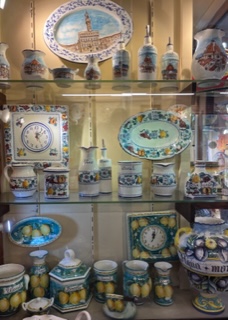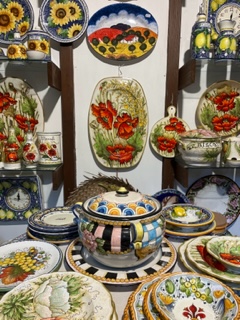Montelupo Fiorentino: A Small Town With A Big History of Art
- lherinckx
- May 30, 2023
- 4 min read
History
Florence is well known for leatherwork and gold jewelry. Visitors from all over the world flock to the Ponte Vecchio to look at expensive gold jewelry, and wander the streets of Florence in search of the leather products that the city is famous for. However, these are not the only products with a long history in the region. Along with leather and jewelry, Florence, and Italy as a whole, is known for its ceramics.
Montelupo Fiorentino, historically known only as Montelupo, is a mere 20 kilometers from Florence and has been a center of ceramic arts since the 13th century due to its proximity to the Arno river and the clay reserves it creates. What started as leaves and animals painted on red bisque has grown over the centuries, and has been heavily influenced by ceramics of west Spain, as majolica was in demand in Italy. Majolica ceramics feature bright colors painted over white, finished with tin glaze that preserves and accentuates the glaze colors used to paint the ceramic pieces. The bright colors and designs of majolica appealed to the Italians, and they began importing foreign pottery. Italian artisans changed their techniques to cater to the public, and changed to a lighter bisque so that the red coloring of the clay they had been using would not show through designs. Pottery techniques continued to change and improve as the Renaissance period came about, around the turn of the 16th century.

Ceramics also became a common sight in apothecaries. Jars designed to hold powder products had large openings at the top for easy access, while those intended for liquids had spouts. Some apothecary ceramics also displayed the insignia of the apothecary to which they belonged, as well as a note of the contents inside. Artisans signed their pieces on the bottom, a practice which is still followed today.
Modern Day Montelupo Fiorentino
Montelupo Fiorentino continues to uphold its tradition of ceramics in the present day. Although the town is small, with a population of less than 15,000, there are a plethora of ceramics shops. The town is also home to the Ceramics Museum of Montelupo Fiorentino. The museum opened in 1983 and has grown over the years. Originally being both a ceramics and archeology museum, the museum split into two separate museums, one focused on ceramics and the other on archeology, in 2007. The ceramics museum has further grown to include an archive and a library, and does programming for visiting school groups. For only five euros, visitors can see more than 3000 ceramic artifacts. Some of these artifacts date back to the 13th century, when ceramics began in the region. The Rosso di Montelupo (1509), which is housed in the museum, is notable for its use of bright red glaze on large areas of the dish, instead of in small portions as usual. The red is also notable for its makeup, as archeologists are still uncertain as to how the color was achieved.

One of the many ceramics shops in Montelupo Fiorentino is La Galleria Montelupo. The shop is a family business. As is the same in many artisan trades, knowledge is passed on through families to carry on the family tradition. Betty Mirenda takes care of La Galleria Montelupo during the day while her son takes visitors on a ceramics experience offered by the store.


“My son makes [the ceramics] here for the experience,” Mirenda explains; as part of the ceramics experience, her son demonstrates ceramics making and lets tourists make pottery as well. The rest of the ceramics displayed for purchase in the shop are made at a workshop elsewhere in the city. The pieces in the shop reflect the bright majolica style the city is known for. Plates displayed in the shop make use of the eye of the peacock’s feather pattern, one of the techniques popularized in the 16th century.

The artistic tradition of Montelupo Fiorentino extends beyond artisan shops and the ceramics museum. The streets are home to large decorative planters, including one, upside down, shaped like a giant head of a roman statue. While Montelupo Fiorentino may be small and quiet, especially in relation to its neighbor, Florence, there is a culture of art that is visible throughout the town.
Ceramics in Florence

Visitors do not have to go to Montelupo itself for authentic ceramic pieces. Galleria Ponte Vecchio, located on Via Guicciardini is tucked back from the street. Instead of selling ceramics made in Florence, the gallery markets pieces made in Montelupo. “There are five to six artists in the town Montelupo Fiorentino that make [the pieces], " Salvatore, the man running the shop, said. Steps from the bridge it takes its name from, the shop has ceramics from wall to wall inside and out. “[The shop] has been going 50 years… my wife and I have been at the shop since 1995,” Salvatore said. Plates, bowls, salt and pepper shakers, vases and ceramic fruits are the most common types of pieces in the shop.
One theme visitors may notice throughout the items on sale--lemons. This is an influence of the Amalfi coast, where the Amalfi variety of lemon is known for its relative sweetness. Historically, sailors used lemons to prevent scurvy, contributing to their popularity along the coast. In Rome, lemons represented wealth and luxury, as they were not grown in the region and only the rich could afford to spend money on them. Now, lemons are an unofficial symbol of Italy, and their popularity has spread further north to Montelupo where they have a strong presence in ceramics today.

Although majolica is not the only style of pottery in Italy, it has spread beyond the region in which it originated and can now be found across the country. Authentic ceramic works can be found for sale throughout Florence; however, for those looking to learn more about ceramics and buy them in a place with a long history in the art, Montelupo Fiorentino is only a short train ride away.














Comments